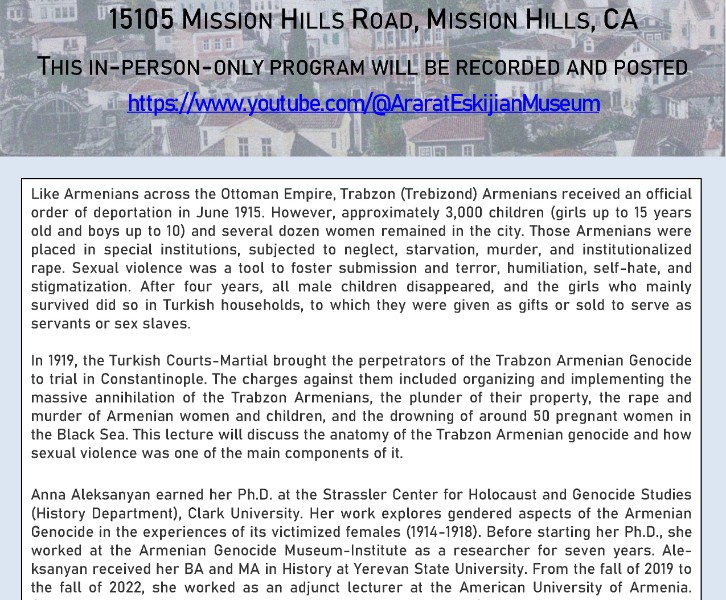The Genocide of the Armenians of Trabzon
Ararat-Eskijian-Museum and Research Center

Sheen Chapel
15105 Mission Hills Rd
Mission Hills CA 91345
Like Armenians across the Ottoman Empire, Trabzon (Trebizond) Armenians received an official order of deportation in June 1915. However, approximately 3,000 children (girls up to 15 years old and boys up to 10) and several dozen women remained in the city. Those Armenians were placed in special institutions, subjected to neglect, starvation, murder, and institutionalized rape. Sexual violence was a tool to foster submission and terror, humiliation, self-hate, and stigmatization. After four years, all male children disappeared, and the girls who mainly
survived did so in Turkish households, to which they were given as gifts or sold to serve as servants or sex slaves.
In 1919, the Turkish Courts-Martial brought the perpetrators of the Trabzon Armenian Genocide to trial in Constantinople. The charges against them included organizing and implementing the massive annihilation of the Trabzon Armenians, the plunder of their property, the rape and murder of Armenian women and children, and the drowning of around 50 pregnant women in the Black Sea. This lecture will discuss the anatomy of the Trabzon Armenian genocide and how sexual violence was one of the main components of it.
Anna Aleksanyan earned her Ph.D. at the Strassler Center for Holocaust and Genocide Studies (History Department), Clark University. Her work explores gendered aspects of the Armenian Genocide in the experiences of its victimized females (1914-1918). Before starting her Ph.D., she worked at the Armenian Genocide Museum-Institute as a researcher for seven years. Aleksanyan received her BA and MA in History at Yerevan State University. From the fall of 2019 to the fall of 2022, she worked as an adjunct lecturer at the American University of Armenia.Currently, Aleksanyan is a postdoctoral fellow at the Armenian Genocide Research Program of the Promise Armenian Institute at UCLA.
Background image: Panorama of Trébizonde, courtesy of Houshamdyan.org
Armenian events around the world
- Armenian events in France
- Armenian events in Uruguay
- Armenian events in Canada
- Armenian events in Armenia
- Armenian events in Italy
- Armenian events in United States
- Armenian events in Belgium
- Armenian events in Australia
- Armenian events in Germany
- Armenian events in Portugal
- Armenian events in Lebanon
- Armenian events in Switzerland
- Armenian events in Argentina
- Armenian events in Israel
- Armenian events in United Kingdom
- Armenian events in Netherlands
- Armenian events in Austria
- Armenian events in Poland
- Armenian events in Spain
- Armenian events in Greece
- Armenian events in Czechia

